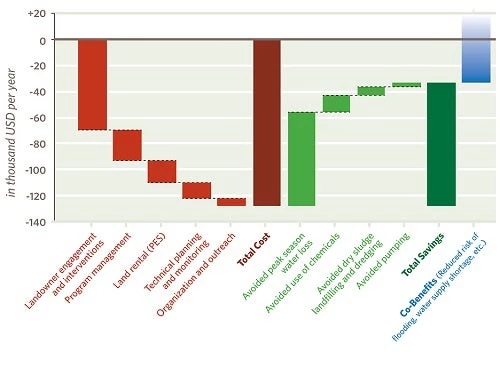
Co-authors:
Timm Kroeger
Senior Environmental Economist,
The Nature Conservancy
Claudio Klemz
Water Policy Specialist,
The Nature Conservancy
Balneário Camboriú is both a famous Brazilian beach destination and a water supply management puzzle. The resident population of the city is just 170,000, but swells to over 800,000 during the tourist season. Like many water utilities facing growing demand and the effects of climate change, the local water company, EMASA, must invest carefully to secure water for its fluctuating customer base.
Unlike many water utilities, however, EMASA is investing in the natural system where its water comes from.
By investing in “natural infrastructure” such as forests through conservation and restoration, EMASA controls soil erosion and the resulting sediment entering the Camboriú River. The result is reduced water treatment costs and water losses. As EMASA’s Environmental Engineer Rafaela Santos says, “This river is the only supply that we have to Camboriú and Balneário Camboriú municipalities, so it’s important that EMASA invests in actions to preserve this resource to last more time and with a better quality”.
Around the world there are a growing number of contractual arrangements—sometimes called “water funds”—between municipal water companies and upstream land owners aimed at improving source water quality or quantity. Nevertheless, the potential of natural infrastructure options for improving water quality or flows far exceeds current spending. According to the Beyond the Source report—which analyzed 4,000 cities to demonstrate the health, climate, and biodiversity benefits of source water protection—costs can be fully offset by water treatment savings alone, in 1 out of 6 cities.
Mobilizing more investments hinges in part on the business case for water users, that is, the competitiveness of watershed conservation programs with conventional engineering solutions.
Yet, remarkably few credible examples of such business cases exist for watershed conservation. Furthermore, those interested in evaluating the business case in their own geography lack the examples and tools to do so in a robust manner.
To fill the gap, scientists from The Nature Conservancy constructed an analytical framework that provides a template for how to conduct a rigorous return on investment (ROI) analysis for watershed conservation programs. This ROI framework connects interventions (forest conservation and restoration) in the watershed to changes in hydrologic outcomes (total suspended solids concentration) and associated economic values for specific water users, like EMASA.
Applying this ROI framework to the Camboriú watershed conservation program, they found that reductions in sediment treatment cost and water losses offset 80 percent of the water company’s investment in the program over a 30-year time horizon, and all of its investment over time horizons of 43 years or more. However, because approximately one fifth of the total program costs are borne by others than EMASA, the program’s ROI as a sediment control measure is
An overall ROI >1 is achievable by sharing costs with beneficiaries of the co-benefits of watershed conservation, including reduced risk of flooding and water supply shortages during the tourist season, to say nothing of protecting imperiled species. Such cost-sharing can be achieved by incorporating watershed conservation costs into the water user fee structure. Recognizing these additional benefits provided by the program, the Balneário Camboriú municipality is concluding a review of a new water tariff structure for EMASA that recognizes watershed conservation as a supply measure and would cover the program’s full operational costs. This outcome represents a fundamental change for water utility operation in Brazil and many other places, which historically have not considered watershed management as part of their infrastructure portfolio.

These findings are typical of the economics of watershed conservation and illustrate the difference between the economic case (ROI of the program overall) and the business case (ROI for specific water users) for watershed conservation. These findings also reveal the importance of counting transaction costs, which can exceed half of total program costs. The benefits for water utility are also varied, including avoided water loss, chemicals use, electricity use for pumping, dredging, and sludge disposal. A credible business case analysis will make these costs and benefits transparent.
This ROI framework offers a useful template to any water user evaluating how to secure their water supply. In doing so, they may find that conserving or restoring nature is a good investment and one they can readily share with other beneficiaries. Indeed, the range of-benefits can be truly remarkable, as detailed in the Beyond the Source report.
For EMASA, this journey began with recognizing nature as water infrastructure, to be considered and financed as other water collection and treatment infrastructure. And while more work is needed, a healthy Camboriú River means a better future for water supply operations.
Learn more and download the full Camboriú River Watershed study at nature.org/Brazilwatershed.


Join the Conversation